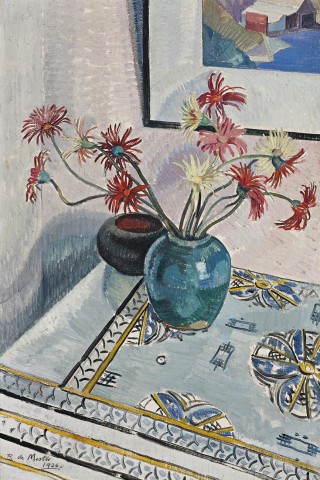GERBERAS, 1926
ROY DE MAISTRE
oil on canvas
76.5 x 51.0 cm
signed and dated lower left: R. de Mestre / 1926
bears inscription verso: 33
Mrs Allan Foott, Sydney
Leonard Joel, Melbourne, 23 September 1966, lot 33 (as ‘Interior, with flowers’)
Ken and Joan Plomley Collection of Modernist Art, Melbourne
possibly: Annual Exhibition of Society of Artists, Sydney, September – October 1926, cats. 79, 80, 91 (all as ‘Flower Piece’)
Johnson, H., Roy de Maistre: The Australian Years 1894-1930, Craftsman House, Sydney, 1988, pl. 33, pp. 72, 74 (illus.), 122
Between 1926 and 1930, Roy de Maistre produced an extended series of floral still life paintings, many with the generic title of Flower Piece. Whilst some, such as Gerberas, 1926, bear titles that identify their subject, the anonymity of the series’ designation followed his attitude that all of these works were, in their genesis, aesthetic studies related to his continuing exploration of modernism and its intersections with contemporary design. De Maistre’s peer, Margaret Preston, also shared this belief and in 1929, published a collection of aphorisms concerning art practice. One of particular relevance read: ‘why there are so many tables of still life in modern paintings is because they are really laboratory tables on which aesthetic problems can be isolated’.1 Gerberas is a sophisticated manifestation of this manner of thinking.
De Maistre had returned to Sydney from Europe around late November, 1925 and held a solo exhibition at Macquarie Galleries in April the following year which included two works titled Flower Piece. These would have been completed prior to his return and probably reflected the intermediate, experimental technique he had developed during his period away from Australia. Indeed, a still life he exhibited at the Société Nationale des Beaux Arts in Paris in 1924 (Nature Mort) followed his earlier tonal-realist style taught by former tutor Max Meldrum. By May 1926, de Maistre had established a permanent studio at the colonial mansion Burdekin House in Macquarie Street and Gerberas most likely belongs to the ‘flower piece’ created during the following months. These are deliberately sumptuous paintings no doubt reflective of the tastes of the wealthy patrons who were his main source of income, though the motif of floral still life was also extensively explored by contemporaneous artists such as Grace Cossington Smith in, for example, Flannel Flowers and Gum Leaves, 1928 (private collection); Elioth Gruner’s Still Life – Mixed Bunch, 1927 (private collection); and Margaret Preston’s Still Life, 1925 (National Gallery of Australia, Canberra), and Western Australian Gum Blossoms, 1928 (Art Gallery of New South Wales, Sydney).
De Maistre’s biographer Heather Johnson notes that the cloth used in Gerberas ‘(has) been identified as French fabric, the most modern available at the time;’2 and he utilised the same piece as a backdrop within one of the floral paintings exhibited at the Annual Exhibition of Society of Artists in 1927.3 In a classic modernist strategy, de Maistre tilts the angle of the table in Gerberas to accentuate his own raised perspective. The ‘oriental’ patterning of the cloth contrasts with the smooth elegance of the highly glazed ceramic pots which sit off-centre, another modernist device in opposition to more formal, centralised compositions. De Maistre employs singular brushstrokes to articulate the forms, a technique also used to great effect by Cossington Smith and the society painter George Lambert. On the wall behind the flowers hangs a memento from his early art-pioneering days, Colour Study, 1920,4 a view of boatsheds on Sydney harbour painted according to his ‘colour music’ theories. In this version, de Maistre has altered the chromatic scale of the original’s cool greens and blues to a slightly warmer purple, terracotta and ochre combination, a further indication of his ‘laboratory table’ focus on the objects before him.
1. Preston, M., ‘aphorism no 46’, in Ure Smith, S. and Gellert, L. (eds.), Margaret Preston recent paintings 1929, Ure Smith, Sydney, 1929
2. Johnson, H., Roy de Maistre: The Australian Years 1894-1930, Craftsman House, Sydney, 1988, p. 72
3. See ‘Society of Artists’ Annual Exhibition – an excellent display’, Sydney Mail, Sydney, 14 September 1927, p. 27 (illus.)
4. Colour Study, 1920, oil on cardboard, 26.5 x 34.5 cm, private collection
ANDREW GAYNOR
